Hither Came Conan: James McGlothlin on “The Servants of Bit-Yakin”
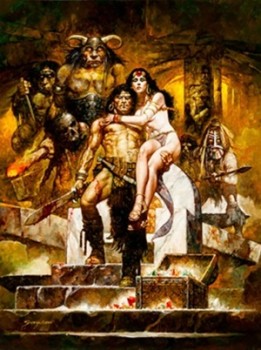
Welcome back to the latest installment of Hither Came Conan, where a leading Robert E. Howard expert examines one of the original Conan stories each week, highlighting what’s best. James McGlothlin drew “The Servants of Bit Yakin” in our Hyborian lottery.
“The Servants of Bit-Yakin” is the best Conan story ever written by Robert E. Howard!
Or at least that’s my assignment (given to me by Bob Byrne) to convince you of such.
Here we go!
If you are familiar with the Conan canon, you will probably think my task quite a challenge. Case in point: The late Fritz Leiber, one of the greatest sword and sorcery writers of all time, and someone who clearly admired Howard’s Conan tales, rated “The Servants of Bit-Yakin” among the worst of the Conan stories ever written calling it “repetitious and childish, a self-vitiating brew of pseudo-science, stage illusions, and the ‘genuine’ supernatural” (“Fantasy Books”, Fantastic, May 1968, p. 143). Oh boy! With such an authoritative voice weighing in on the supposed poor quality of “Bit Yakin”, I have quite the task set before me. But before getting on to my attempt to convince you that this story is the best Conan story ever written by Howard, let’s get a little background on the tale first.
Though originally titled by Robert E. Howard as “The Servants of Bit-Yakin”, it first appeared in Weird Tales, March 1935 as “Jewels of Gwahlur”. The story was later reprinted in King Conan (Gnome Press, 1953), Conan the Warrior (Lancer Books, 1967), as well as various other later collections. Also, Roy Thomas and Dick Giordano famously adapted it for Marvel Comic’s Savage Sword of Conan #25 in 1977 and the story also later appeared in Dark Horse comics in 2005. This story has some legs; so perhaps it’s better than Leiber thought!
It’s hard to quickly summarize “The Servants of Bit-Yakin”. But I will try to be as brief as I can with the following.
We begin the story with Conan heroically climbing a rock face. In typical Howard fashion, it is clearly communicated how impossible this would be for any normal human being to do the same. But for Conan, with his panther-like strength, it seems not much harder than a jog in the park. While climbing though, Conan comes across a small cave with a mummy holding an inscribed parchment. Conan grabs this ancient document and then completes his climb (the parchment comes into play later). At the top Conan finds on the other side of the cliffs the ancient ruins of the city of Alkmeenon.
The tale then shifts to some backstory to let us know how and why Conan has arrived here. Following rumors of a magnificent treasure called “the teeth of Gwalhur”, Conan had recently travelled into Keshan (part of Hyborian Africa) to offer his military services. Shortly after a Stygian thief named Thutmekri, and his partner Zargheba, both who are also intent on finding this rumored treasure as well, arrive to offer a military alliance to Keshan with Zembabwei.
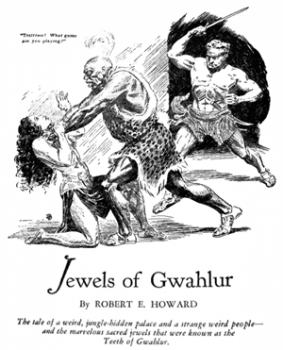
But Thutmekri claims that he needs some of the fabled Gwalhurian “teeth” to seal the pact. The Keshan high priest, Gorulga, claims that such a momentous decision can only be made after consulting Yelaya, the goddess located at Alkmeenon, which has not been attempted in many years since the last few bands of priests who went there never returned. Conan, desiring to obtain these precious jewels, and suspecting that Thutmekri and Zargheba will now race on to get them as well, decides to immediately seek out Alkmeenon.
We then flash back to the present to where we left Conan’s arriving in the ancient and ruined city of Alkmeenon. Howard does a really good job here of building atmosphere and suspense. Conan finds the ruins of Alkmeenon to be deserted and eerie. Searching for the jewels, Conan experiences several uncanny things that evidence an unseen and possibly even supernatural malice. For example, he investigates the sounding of a gong and falls prey to either an accident or a seeming trap. Though escaping this, Conan goes on to discover an image or statue of the goddess Yelaya, which seems to be mysteriously coming to life.
The atmosphere of the story quickly changes though, when Conan discovers that the statue of Yelaya is actually an imposter, a dancing girl named Muriela. Once the ruse is discovered she confesses to Conan that Zargheba (who is hiding elsewhere in Alkmeenon) has forced her to trick the soon-to-arrive priest Gorulga to give up the location of the jewels to Thutmekri. Conan agrees to free Muriela from Zargheba if she will follow through on a new plan of continuing to impersonate Yelaya and then telling the priest that Yelaya’s will is for Conan to have the jewels.
Soon, Gorulga and his acolytes arrive to consult “Yelaya” (i.e. Muriela) and the new ruse seems to go through as Conan has planned. But, unfortunately, one of the men with Gorulga is actually a spy for Thutmekri named Gwarunga. Gwarunga knows full well how Zargheba’s plan was supposed to go down and so after Gorulga leaves with his toadies to get the fabled teeth/jewels of Gwalhur, Gwarunga slips back to confront Muriela.
But Conan jumps out to defend her and seems to end up killing Gwarunga. But once Conan’s attention is diverted, Gwarunga’s body disappears and there are hints that the statue of Yelaya has actually come to life and has kidnapped Muriela. The supernatural now seems a reality again in the story. (Are you catching all this?)
After attempting, unsuccessfully, to follow after Muriela, but not giving up on her, Conan goes to follow after Gorulga and his acolytes to get the jewels of Gwalhur. Surprisingly though, the original statue of Yelaya appears to the priests and tells them that they have been duped by their earlier consultation with a fake Yelaya. They are now told by the “true” Yelaya that the jewels of Gwalhur must actually be given to Thutmekri and Conan should be skinned alive as a traitor. Gorulga and company hurry off to retrieve the jewels.
After the priests leave, Conan rightly suspects another ruse and so investigates the image of Yelaya and sees that it is just the old inanimate statue of Yelaya but that Gwarunga, whom Conan thought he had killed, was actually the voice impersonating Yelaya. Conan fights Gwarunga again and this time clearly kills him and also ends up finding Muriela, who claims that she had been abducted by some hideous, gray-haired, ape-like creatures.
Since Conan was able to read the parchment he earlier lifted from the mummy, Conan realizes that these creatures are the former servants of Bit-Yakin, Bit-Yakin evidently having been the mummified form.
Conan returns to go after Gorulga and crew to try and get the jewels of Gwalhur. But before he can accomplish this, the servants of Bit-Yakin pop out and gruesomely kill the Yelayan priests, thus explaining why earlier bands of priests had not returned from Alkmeenon. Conan successfully filches the chest of jewels and attempts to escape with Muriela. Unfortunately, he is followed by one of the servants of Bit-Yakin and attacked. In the midst of the battle, the creature attempts to take off with Muriela and the jewels.
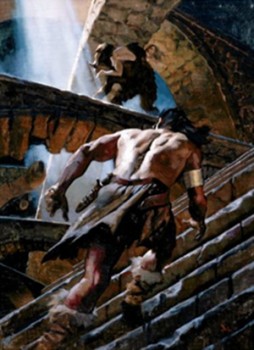
But having received a deep wound from Conan, it falls to icts death from a precipice dropping both the treasure chest and Muriela. In the most heroic scene of the book, Conan must decide to grab the priceless jewels or save the dancing girl Muriela. He unhesitatingly saves the latter! The story ends with Conan leaving with Muriela but hatching a further plan, this time against Keshan, his former employer.
If all of that seemed sort of hard to follow, there are actually quite a few more interesting details that I’ve left out. But I think you can get the overall plot of the story.
So why is “The Servants of Bit-Yakin” the best Conan story every written? Here’s why.
First, it has one of the greatest opening scenes of any Conan tale. It’s incredibly cinematic in detail and immediately draws you into the story, establishing Conan’s strength, courage and determination. The plot setup is also fairly unique compared to other Conan tales in that it starts with a wilderness and ancient ruins, then builds up by going back in time to the civilization of Keshan and the backstory conflict between Conan and Thutmekri, and then returning to the tale at hand. This “flashback” does a great job of putting forward the political intrigue, the mystery and possible danger, and the promise of a fabled treasure that sets up Conan’s present quest.
Second, the creepy setting of Alkmeenon is one of the most effectively chilling settings in any Howard story, right up there in the same league with his horror tales. There are numerous excellent scenes in this story that tangibly portray the eerie ruins of Alkmeenon as well as setting the stage with possible supernatural menace.
One memorable example (not given in my summary) is Conan’s discovery of Zargheba’s corpse, which is pretty shocking. I won’t give it away but I was completely surprised, and creeped out! The incident immediately indicates that there is much more going on in the story than just the competitive and political race to the jewels.
But the greatest thing about this story is, by far, the ending, which gives us the typical Conan who is strong, smart, and crafty, but who is also ultimately good in his own mixed way. Howard’s portrayal of Muriela as a “dancing girl” suggests that she is really nothing more than a slave to Zargheba, someone of not much consequence in the Hyborian world, while the “teeth” of Gwalhur are clearly priceless, or at least of very great price.
Nevertheless, at the end of the story Conan has absolutely no struggle with any sort of utilitarian calculus in deciding whether to rescue Muriela over the jewels. However, after this heroic feat, Conan almost immediately begins plotting against his former employer in hopes of making a profit. But this traitorous shift only highlights the virtuous core of Conan in saving Muriela. Conan is an atypical “white hat” hero, but he is still a true hero at heart.
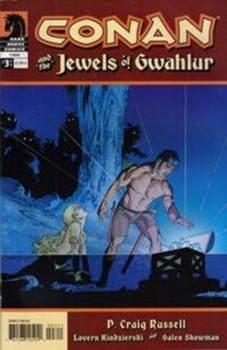 But some critics, such as the late and venerable Fritz Leiber, take “The Servants of Bit-Yakin” to be a not-very-good Conan story, on several counts. But I think these supposed “weaknesses” actually show various strengths in the story, and I’ll demonstrate this by looking at just two.
But some critics, such as the late and venerable Fritz Leiber, take “The Servants of Bit-Yakin” to be a not-very-good Conan story, on several counts. But I think these supposed “weaknesses” actually show various strengths in the story, and I’ll demonstrate this by looking at just two.
Some complain that the plot of this story tends to “ping-pong” about because it is hard to keep up with what is going on in the story. You probably got a feel for that in my summary. One could complain that Howard has got too many characters doing too many things at too many cross-purposes. But I offer the following pushback: This just shows how action-packed the story actually is. The plot moves along at a fairly quick clip and this is why the story is so hard to summarize: there’s so much going on! But that’s not a weakness: that’s a Hollywood blockbuster formula!
Two, some also complain about Muriela as being nothing more than a typical damsel in distress, a woman with no agency who is simply a set piece for the hero to rescue—a “trophy” to be won if you will. Patrice Louinet shows how this sort of female character is unusual at this point in Howard’s career (July, 1934) since most of the stories he publishes during this time have strong female characters (see his The Robert E. Howard Guide, p. 137).
But I think Muriela has more going for her than this initial characterization suggests. It seems to me that she is pretty good at keeping her head in the midst of—not one but two—charades and also does a fair job of not losing it around the beastly servants of Big-Yakin. Though Muriela does indeed display some of the typical lady-in-need-of-help traits (e.g. beautiful, scared, seemingly weak, weepy, etc.), she also is surprisingly resourceful and I think displays a fair modicum of courage. (I personally would not have kept myself as together as she did in such situations!) I think Muriela is simply a woman who is just trying to make the best of the bad situations she has been forced into.
But more importantly, I think she is more than a mere “trophy” for Conan in the end. Given his heroic choice of choosing to save her over retrieving the perhaps priceless jewels of Gwalhur, I think his saving her highlights her value and dignity as a human being as having high and intrinsic worth. One might argue that Conan is just a sexually charged barbarian who values a good roll in the hay over money; thus, he eschews the treasure for the girl.
But Conan is no dummy. He knows that the jewels of Gwalhur are of high monetary value and thus would buy him (among other things) a good many visits to any number of high-end brothels. His refusal to go for the treasure over Muriela shows that he sees the lowly dancing girl (not a queen or princess) as worth much more than any such treasure, or even any possible sexual exploit. In the eyes of Conan, she must be worth much more than being a simple “trophy” or sexual escapade. That’s true virtue shining through.
So, critics be damned! (Actually Mr. Leibniz, I hope you’re experiencing eternal bliss right now.) But the naysayers are just wrong. As I’ve shown above, “The Servants of Bit-Yakin” is clearly the greatest Conan story ever written by Robert E. Howard. This story has it all! Action! Horror! Ethics!
In all honesty, I’m just glad I didn’t have to defend “The Vale of Lost Women” as the best Conan story ever written.
From the Dusty Scrolls (Editor comments)
This story appeared in the March, 1935 issue of Weird Tales. It was renamed “The Jewels of Gwahlur” (presumably by editor Farnsworth Wright), and it did not get the cover. That went to Harold Ward’s “The Clutching Hands of Death.”
Shortly before writing “Servants of Bit-Yakin,” Howard had taken a week-long trip with friend Truett Vinson. They visited Carlsbad Cavern, in New Mexico. In a letter to H.P. Lovecraft, he wrote, “I cannot describe the fantastic wonders of that great canyon,” then waxed eloquently about it for several pages. Carlsbad influenced his creation of Alkmeenon.
L. Sprague de Camp is a fan of this tale. In his Dark Valley Destiny, he said it “is considered one of the very best Conan stories.” Also, “In this blood-tingling sestting, Conan begins one of his most unforgettable adventures – an adventure in which he needs all his strength, skill, and courage. The opening lines of this magnificent tale show Howard’s fully developed descriptive power and his effective use of colors…”
In Blood & Thunder, Mark Finn is less impressed: “The next story, “The Servants of Bit-Yakin,” is likewise uneven.” Likewise, David C. Smith in Robert E. Howard: A Literary Biography, calls it an “adequate, if routine, Conan” adventures. Add Patric Louinet to the list of the unipmressed: “The story is not a particularly memorable one, with a rather unconvincing plot and insipid heroine…”
Dark Horse adapted this story as a three-issue one-shot, Conan and the Jewels of Gwahlur in April, May, and June of 2005. Bill Ward liked it. Marvel’s Savage Sword of Conan covered it in issue 25 (1977), impressing Howard Andrew Jones.
Thutmekri appears in two issues of Savage Sword of Conan, and in one of Conan the Barbarian. Roy Thomas must have liked the character!
Prior Posts in the Series:
Here Comes Conan!
The Best Conan Story Written by REH Was…?
Bobby Derie on “The Phoenix in the Sword”
Fletcher Vredenburgh on “The Frost Giant’s Daughter”
Ruminations on “The Phoenix on the Sword”
Jason M Waltz on “The Tower of the Elephant”
John C. Hocking on “The Scarlet Citadel”
Morgan Holmes on “Iron Shadows in the Moon”
David C. Smith on “The Pool of the Black One”
Dave Hardy on “The Vale of Lost Women”
Bob Byrne on Dark Horse’s “Iron Shadows in the Moon”
Jason Durall on “Xuthal of the Dusk”
Scott Oden on “The Devil in Iron”
Next Week it’s Keith J. West with “Beyond the Black River”
James McGlothlin is Assistant Professor of Philosophy and Theology at Bethlehem College & Seminary in Minneapolis, Minnesota. When not reading fantasy, horror or SF for fun, James enjoys studying from a wide range of topics: everything from Old English to ethics, aesthetics, and the theology of Jonathan Edwards. He was also senior lecturer at THE Ohio State University (where I got my Masters Degree).
 Bob Byrne’s ‘A (Black) Gat in the Hand’ was a regular Monday morning hardboiled pulp column from May through December, 2018.
Bob Byrne’s ‘A (Black) Gat in the Hand’ was a regular Monday morning hardboiled pulp column from May through December, 2018.
His ‘The Public Life of Sherlock Holmes’ column ran every Monday morning at Black Gate from March, 2014 through March, 2017 (still making an occasional return appearance!).
He also organized Black Gate’s award-nominated ‘Discovering Robert E. Howard’ series.
He is a member of the Praed Street Irregulars, founded www.SolarPons.com (the only website dedicated to the ‘Sherlock Holmes of Praed Street’) and blogs about Holmes and other mystery matters at Almost Holmes.
He has contributed stories to The MX Book of New Sherlock Holmes Stories – Parts III, IV, V and VI.
And he will be in the anthology of new Solar Pons stories coming this Spring.
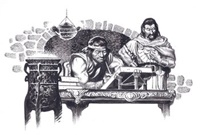
Well, since L. Sprague de Camp liked it, it indeed obviously MUST be one of the best Conan stories! (Dramatic pause to listen to gasps of horror from Howard purists.) Particularly since he and Lin Carter (or perhaps Catherine Crook de Camp, as per Loay Hall) saw fit to sequelize it with “The Ivory Goddess,” in which Muriela makes an even bigger splash. (More horrified gasps.) What? I’m a de Camp fan. So sue me.
But yeah, all kidding aside, I’m inclined to agree with James that this story has definite merits. While he doesn’t convince me it’s the greatest Conan story, it’s certainly a cut above the “Conan stumbles onto a lost city” plot I’ve been decrying lately. I mean, hey, he’s got a REASON to go there! I like a Conan story in which he goes in with an actual plan, rather than just finding himself in a situation in which all he can do is duck as cat after (magical?) cat is thrown at him! One just ends up feeling sorry for the Cimmerian, and it’s a waste of cats.
Not convinced Brian? (*shocked* gasp)
No shade towards de Camp but when I saw that Bob included that comment my immediate thought was “That makes my case even harder to prove!”
Nope, not convinced. Though I erred in saying Conan would duck the cats. He would slice each one neatly in half as it came. Poor kitties!
I wouldn’t worry about de Camp’s opinion undermining your case, though. The general tendency of Howardians to discount him should not work against you here, since he’s actually praising Howard. “De Camp is always wrong; Howard was the greatest–oh. He agrees? Never mind…”
If anything, you can turn this into a plus by saying “See? See? Even de Camp realized this was a great story!”
My thought was that since that well (i.e. de Camp) is so widely held to be poisoned, that gives impetus for confirming a negative conclusion. It seems to me, then, that it would take a little more argumentation to turn that quotation into a plus.
And, in all honesty, the piece is more of a fun investigation than anything else, giving people a reason to read or reconsider the story. Bob Byrne’s directive (hook) was to make a case for the story to be the best in the Conan canon, which was a great idea!
Thank you, Mr. McGlothlin!
I’ve always enjoyed this story and I think you’ve done a great job of describing why. But I think that there is something more than ethics moving Conan to save Muriela, I think it is his innate ability as a leader of men and women.
Once Muriela agrees to his plan and does her best to hold up her end of the bargain, Conan sees her not just as an attractive woman, but as one of HIS people, one of his followers. He could no more let her fall to her death than he could abandon a pirate or kozak warrior who was facing death because they had followed his orders. He is a leader who will not leave those who follow him behind.
This personal loyalty is part of how he is able to win Trocero, Prospero and Albiona as such loyal followers when he become king of Aquilonia. To Conan, loyalty to a friend or faithful follower flows both ways.
So let me add to your motto:
Action! Horror! Ethics! Leadership!
Hear hear JEB!
While I do not think it is near the best, I compliment you on a great job of making the case!
Thanks Terry2007!
Great post, James. I’ve always liked this one. I especially like how deliciously creepy Conan’s discovery of Zargheba’s body is.
BTW, Bob. My middle initial isn’t J. You must be thinking of David J. West. A common misunderstanding, as we’re both dashing, debonair, and devilishly handsome in spite of not being related. 🙂
Thanks westkeith! I agree about the discovery of Zargheba’s body scene. It’s probably the creepiest scene in the story.
Mr Boyle summed it up well, I am in full agreement with him.
Also a personal favourite of mine which is easily memorable. As per the “story has some legs” indeed in my personal experience I seem to have encountered this The Servants of Bit-Yakin / The Jewels of Gwalhur in a few anthologies etc.
Nice job, James. And I agree, John, that two-way loyalty is a big part of Conan.
Thanks Jason!